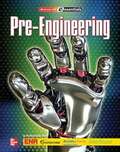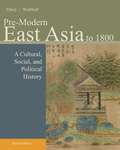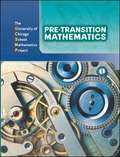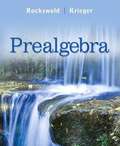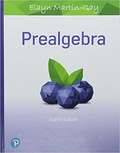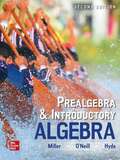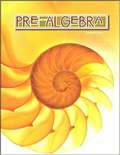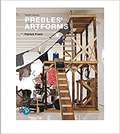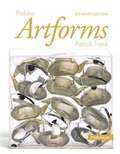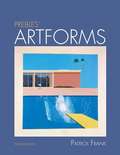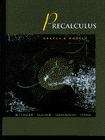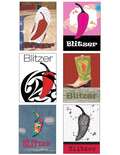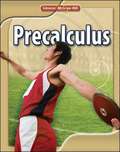- Table View
- List View
Pre-AP® Algebra 1 Student Resources Unit 1: Linear Functions and Linear Equations
by College BoardThe Pre-AP Algebra 1 course is designed to deepen students’ understanding of linear relationships by emphasizing patterns of change, multiple representations of functions and equations, modeling real world scenarios with functions, and methods for finding and representing solutions of equations and inequalities. Taken together, these ideas provide a powerful set of conceptual tools that students can use to make sense of their world through mathematics. The Key concepts of Unit 1 are: Constant rate of change and slope, Linear functions, Linear equations, Linear models of nonlinear scenarios, Two-variable linear inequalities.
Pre-AP® Algebra 1 Student Resources Unit 2: Systems of Linear Equations and Inequalities
by College BoardThe Pre-AP Algebra 1 course is designed to deepen students’ understanding of linear relationships by emphasizing patterns of change, multiple representations of functions and equations, modeling real world scenarios with functions, and methods for finding and representing solutions of equations and inequalities. Taken together, these ideas provide a powerful set of conceptual tools that students can use to make sense of their world through mathematics. The Key concepts of Unit 2 are: The solution to a system of equations, Solving a system of linear equations algebraically, Modeling with systems of linear equations, Systems of linear inequalities.
Pre-AP® Algebra 1 Student Resources Unit 3: Quadratic Functions
by College BoardThe Pre-AP Algebra 1 course is designed to deepen students’ understanding of linear relationships by emphasizing patterns of change, multiple representations of functions and equations, modeling real world scenarios with functions, and methods for finding and representing solutions of equations and inequalities. Taken together, these ideas provide a powerful set of conceptual tools that students can use to make sense of their world through mathematics. The Key concepts of Unit 3 are: Functions with a linear rate of change, The algebra and geometry of quadratic functions, Solving quadratic equations, Modeling with quadratic functions.
Pre-AP® Algebra 1 Student Resources Unit 4: Exponent Properties and Exponential Functions
by College BoardThe Pre-AP Algebra 1 course is designed to deepen students’ understanding of linear relationships by emphasizing patterns of change, multiple representations of functions and equations, modeling real world scenarios with functions, and methods for finding and representing solutions of equations and inequalities. Taken together, these ideas provide a powerful set of conceptual tools that students can use to make sense of their world through mathematics. The Key concepts of Unit 4 are: Exponent rules and properties, Roots of real numbers, Sequences with multiplicative patterns, Exponential growth and decay.
Pre-Calculus with Trigonometry Version 4.0
by John Cooper Rebecca Bobell Kevin Coffey Jonathan WeastNIMAC-sourced textbook
Pre-modern East Asia To 1800: A Cultural, Social, And Political History
by Patricia Buckley Ebrey Anne WalthallWritten by top scholars in the field, PRE-MODERN EAST ASIA: A CULTURAL, SOCIAL, AND POLITICAL HISTORY, VOLUME I: To 1800, 3E delivers a comprehensive cultural, political, economic, and intellectual history of East Asia, while focusing on the narratives and histories of China, Japan, and Korea in a larger, global context. Full color inserts on such topics as food, clothing, and art objects illustrate the rich artistic heritage of East Asia. A range of primary source documents is included throughout, while intriguing biographical sketches highlight the lives of popular figures as well as ordinary people.
Pre-Transition Mathematics (The University of Chicago School Mathematics Project)
by John W. Mcconnell Cathy Hynes FeldmanNIMAC-sourced textbook
Prealgebra
by Tom CarsonAddressing individual learning styles, Tom Carson presents targeted learning strategies and a complete study system to guide students to success. Carson’s Study System, presented in the “To the Student” section at the front of the text, adapts to the way each student learns, and targeted learning strategies are presented throughout the book to guide students to success. Tom speaks to students in everyday language and walks them through the concepts, explaining not only how to do the math, but also where the concepts come from and why they work.
Prealgebra
by Terry A. Krieger Gary K. RockswoldThe Rockswold/Krieger algebra series fosters conceptual understanding by using relevant applications and visualization to show students why math matters. It answers the common question "When will I ever use this?" Rockswold teaches students the math in context, rather than including the applications at the end of the presentation. By seamlessly integrating meaningful applications that include real data and supporting visuals (graphs, tables, charts, colors, and diagrams), students are able to see how math impacts their lives as they learn the concepts. The authors believe this approach deepens conceptual understanding and better prepares students for future math courses and life.
Prealgebra
by Elayn Martin-GayElayn Martin-Gay is known for her accessible writing style with built-in study skills and support. <P><P> An emphasis on study skills is incorporated through the text. <P><P>In-text study skills resources include Section 1.1, Tips for Success in Mathematics, in which Elayn covers important strategies for success, with videos to motivate for each objective. <P><P>Additional in-text resources include the Student Resources section in the back of the text, which include Study Skill Builders, a Study Guide Outline, and Practice Final Exam. <P><P>Detailed step-by-step examples provide guidance for students, and practice margin exercises are paired with each example to actively involve students in the learning process. <P><P>Helpful Hints, strategically placed where students are most likely to need immediate reinforcement, help students avoid common trouble areas and mistakes. <P><P>All exercise sets have been carefully updated with this revision. Several special types of exercises throughout the text include Mixed Practice, Concept Extension, and more!
Prealgebra And Introductory Algebra
by Hawkes Learning SystemsThe purpose of Prealgebra and Introductory Algebra is to provide students with a review of basic arithmetic, an introduction to algebra, and a learning tool that will help them: 1. review basic arithmetic skills, 2. develop reasoning and problem-solving skills, 3. become familiar with algebraic notation, 4. understand the connections between arithmetic and algebra, 5. develop basic algebra skills, 6. provide a smooth transition from arithmetic through prealgebra to algebra, and 7. achieve satisfaction in learning so that they will be encouraged to continue their education in mathematics.
Prealgebra and Introductory Algebra
by Julie Miller Molly O'Neill Nancy HydeCreate more lightbulb moments with this comprehensive set of valuable content and insightful, intuitive digital learning resources! This new 2nd edition of the Miller/O'Neill/Hyde Prealgebra and Introductory Algebra text seeks to serve the changing dynamics of today's curriculum by thoughtfully interweaving the topics of two foundational building blocks in students' mathematical journey. The text reflects the compassion of its experienced author team with features developed to address the specific needs of today's prealgebra and introductory algebra students. Included alongside the highly-favorable Problem Recognition Exercises, readers will find added review material, aimed at assisting students with synthesis, summarization, and recognition of key mathematical topics so as to enhance their overall conceptual understanding. These types of exercises, along with the overall number of practice problems and group activities available, permit instructors to choose from a wealth of problems, allowing ample opportunity for students to practice what they learn in lecture to hone their skills.
Prealgebra (Second Edition)
by Larry L. Hall Kathy Kohler Mark WetzelNever HIGHLIGHT a Book Again Includes all testable terms, concepts, persons, places, and events. Cram101 Just the FACTS101 studyguides gives all of the outlines, highlights, and quizzes for your textbook with optional online comprehensive practice tests. Only Cram101 is Textbook Specific. Accompanies: 9781591665465. This item is printed on demand.
Prealgebra (Third Custom Edition for Valencia Community College)
by Elayn Martin-GayThe book intends to help students make the transition from arithmetic to algebra and show them the relevancy of mathematics in everyday life and in the workplace.
Prebles' Artforms
by Patrick FrankWe form art. Art forms us. The title of this book has a dual meaning. As humans form works of art, we in turn are formed by what we have created. Such human creativity influences and stimulates us. Several editions ago, this book's title was changed to Prebles' Artforms, acknowledging the pioneering contribution of the original authors, Duane and Sarah Preble. They first posited the emphasis on our two-way interaction with works of art, and that emphasis continues to inform every page of this book. Why study art? Because artists have dealt at one time or another with nearly every aspect of the human experience, from the common to the forbidden, the mundane to the sacred, the repugnant to the sublime. Artistic creativity is a response to being alive, and by experiencing such creativity, we enrich our experience of life. Behind all of the learning objectives, new terms, quizzes, flashcards, and writing prompts that accompany this book, there is a wealth of visual creativity that has constantly informed, surprised, inspired, challenged, or thrilled by Patrick Frank.
Prebles' Artforms
by Duane Preble Sarah Preble Patrick FrankWe form art. Art forms us. The title of this book has a dual meaning. As humans form works of art, we are in turn formed by what we create. The art world constantly evolves, as today’s artists interpret, challenge, and ultimately create the world around them. The 11th edition of Prebles’ Artforms reflects this dynamic environment; it is one of the most exhaustive revisions in the book’s history. Three recent trends drive this edition: changing pedagogical needs, new scholarly research, and recent creativity by artists around the world.
Prebles' Artforms
by Duane Preble Sarah Preble Patrick L. FrankPrebles' Artforms continues to lead the field with its steadfast focus on contemporary art, global artists, and cutting edge technology for the art appreciation classroom. We form Art. Art forms us. The title of this book has a dual meaning. Besides the expected discussion of the various forms of art, the title also reflects the fact that art does indeed help to form us as people. As we create forms, we are in turn formed by what we have created. Several years ago, the title was changed to Prebles' Artforms, acknowledging the pioneering contribution of the original authors, Duane and Sarah Preble, to the study of art. Their vision and spirit have touched hundreds of thousands of students who have studied this book. Artforms grew out of a desire to introduce art through an engaging visual experience, and to expose students to a culturally diverse canon of work. It is written and designed to help readers build an informed foundation for individual understanding and enjoyment of art. By introducing art theory, practice, and history in a single volume, this book aims to draw students into a new or expanded awareness of the visual arts. Beyond fostering appreciation of major works of art, this book's primary concern is to open students' eyes and minds to the richness of the visual arts as unique forms of human communication and to convey the idea that the arts enrich life best when we experience, understand, and enjoy them as integral parts of the process of living.
Precalculus: Graphs & Models, 2nd Edition
by Marvin L Bittinger Judith A. Beecher David Ellenbogen Judith A. PennaPrecalculus: Graphs and Models, Second Edition, covers college-level algebra and trigonometry and is appropriate for a one- or two-term course in precalculus mathematics.
Precalculus
by Carter Cuevas DayGlencoe Precalculus ©2011is a comprehensive program that prepares students to be successful in college or AP Calculus programs. Features of this program include: Chapter 0, Graphing Technology Labs, leveled exercise sets, H. O. T. (Higher-Order Thinking) Problems, and Preparation for AP Calculus lessons within every chapter. Glencoe Precalculusalso includes a complete technology suite that contains an online student edition, online teacher edition, Interactive Classroom, Advance Tracker, andExamView® Assessment Suite.

